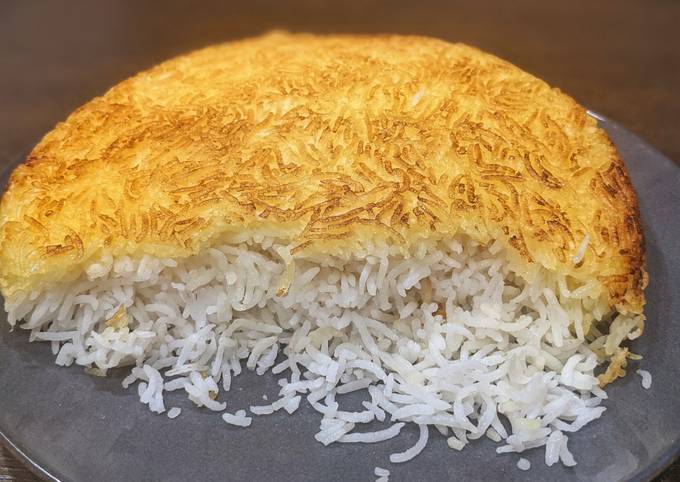Tahdig (Persian rice). Rice is "Polo" in Farsi, and it is the most important component of some Persian dishes; specifically all of the khoresh 'stews'. By popular demand, I have finally made you guys a video on how to make Persian Rice with Tahdig. Tahdig is a Persian rice dish, cooked in two stages, that has a very crispy bottom.
 It is a Persian style of rice that has a crispy bottom, which is the best part. The word "tahdig" means "bottom of the pot", which is exactly. How to Cook Persian Tahdig at Home. Tahdig (Persian rice) most diverse and own mind sense that unique. Some kinds of Tahdig (Persian rice) recipes are also sufficient simple to process and dont take long. Even though not everybody likes Tahdig (Persian rice) food, currently few people are get attached and like the sundry Tahdig (Persian rice) foods available. This can be seen than the number of restaurants that prepare Tahdig (Persian rice) as one of the dish. You can cook Tahdig (Persian rice) using 6 ingredients and 5 steps. Here is how you achieve it.
It is a Persian style of rice that has a crispy bottom, which is the best part. The word "tahdig" means "bottom of the pot", which is exactly. How to Cook Persian Tahdig at Home. Tahdig (Persian rice) most diverse and own mind sense that unique. Some kinds of Tahdig (Persian rice) recipes are also sufficient simple to process and dont take long. Even though not everybody likes Tahdig (Persian rice) food, currently few people are get attached and like the sundry Tahdig (Persian rice) foods available. This can be seen than the number of restaurants that prepare Tahdig (Persian rice) as one of the dish. You can cook Tahdig (Persian rice) using 6 ingredients and 5 steps. Here is how you achieve it.
Ingredients of Tahdig (Persian rice)
- It's 1 cup of basmati rice.
- It's 3 tbsp of butter.
- You need of olive oil.
- It's of water.
- Prepare 5 strands of saffron.
- Prepare 1 tbsp of salt.
Rice—called polo in Farsi—is a staple side dish in Persian cuisine. It's often prepared by steaming with oil or butter to create a crispy layer of rice on the bottom. Persian rice cookers crisp rice to make tahdig, the crunchy layer of rice at the bottom of the pot. Here's how to use one for fast weeknight dinners.
Tahdig (Persian rice) instructions
- Rinse the rice a few times to remove the starch; until the water is clean. Then keep it soaked in water with 1 tbsp of salt for 20 minutes. Meanwhile, put water to boil in a pot..
- Add the rice to the pot and cook it in the boiling water for ~6 minutes or until it's soft from outside but still hard inside. Meanwhile, add 2 tbsp of warm water in a cup and add the saffron; this will tint the water..
- Take the rice out of the pot when ready and put 1/3 of the semi cooked rice in a mixing bowl along with the saffron water and gently mix it to tint that part of the rice..
- Add 2 tbsp of butter to an empty put along with 1 tbsp of olive oil. Put it in medium high heat until the butter melts and then add the saffron rice on a single layer. Then on top of that add the rest of the (white) rice trying to make a conic / bell shape. Make some "holes" to the bottom to steam it properly and add the rest of the butter on top. Cover it (ideally with a cloth between the pot and the lid) and cook it for ~20 minutes or until a crust is formed on the bottom and sides..
- Lower the hear to medium low for another 20 to 30 minutes or until the rice is fully cooked and dry. Uncover it and put a dish or tray on top of the pot and then flip it..
Specifically, I missed Persian rice with tahdig—the prized golden, crispy crust at the bottom of the Rice is the crown jewel of Persian cuisine, and Iranians have elevated its preparation to an art form. Persian Rice with Tahdig with a popular staple in Persian cuisine using basmati rice and saffron to create a golden crispy rice bottom. Growing up Persian, one of our staple side dishes we eat with all. Tahdig (pronounced tah-DEEG) is a crispy, browned layer of rice formed at the bottom of a pot by frying parboiled rice to a crisp while the rice on top steams. Louisa Shafia, Persian food expert and.
Obtain ingredients for manufacture Tahdig (Persian rice) recipes is also not difficult. You can easily get the main ingredients at the closest supermarket and even on the market. There are many types of Tahdig (Persian rice) that are simple and quick to process into delicious dishes. You can always praxis this Tahdig (Persian rice) recipe at home, and can serve it to your children and extended family. If you want to cook other foods on our website, we provide various types of food recipes which are of course very delicious and enjoyable to enjoy, please try them.
0 comments:
Post a Comment